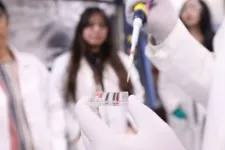(Press-News.org) Barcelona, Spain: Researchers have shown that they can accurately re-create clinical trials of new treatments using ‘digital twins’ of real cancer patients. The technology, called FarrSight®-Twin, which is based on algorithms used by astrophysicists to discover black holes, will be presented today (Friday) at the 36th EORTC-NCI-AACR [1] Symposium on Molecular Targets and Cancer Therapeutics in Barcelona, Spain.
The researchers say that this approach could be used by cancer researchers to run virtual clinical trials before testing new treatments on patients. It could also be used alongside clinical trials with a digital twin for each patient taking part, which together could form a control group for any trial. Ultimately, it might mean that patients could have different treatments tested on their digital twin to help select the most suitable treatment ahead of time.
The research is presented by Dr Uzma Asghar, Co-founder and Chief Scientific Officer at Concr and a consultant medical oncologist, currently working at The Royal Marsden NHS Foundation Trust, London, UK. She said: “Around the world, we spend billions of dollars on developing new cancer treatments. Some will turn out to be successful, but most will not.
“We can use digital twins to represent individual patients, build clinical trial cohorts and compare treatments to see if they are likely to be successful before testing them out with real patients.”
Each digital twin is created from biological data from thousands of patients with cancer who have been treated in different ways. This information is combined to recreate the cancer of a real patient with molecular data on their tumour. This digital twin makes it possible to predict how a patient is likely to respond to a treatment.
Dr Asghar and her colleagues used this approach to recreate published clinical trials with a digital twin representing each real patient who took part in the trial. Overall, the digital trials accurately predicted the outcome of the actual clinical trials in all simulated clinical studies. Further testing showed that where patients received the treatment predicted by FarrSight®-Twin to be best, they had a 75% response rate, compared to 53.5% response where patients received a different treatment. ‘Response rate’ means the proportion of patients whose tumours shrank following treatment.
The trials they used in the study presented at the Symposium were in patients with either breast, pancreatic or ovarian cancer. They were phase II or III trials that compared two different drug therapies, including anthracyclines, taxanes, platinum-based drugs, capecitabine and hormone treatments.
Dr Asghar said: “We are excited to apply this type of technology by simulating clinical trials across different tumour types to predict patients’ response to different chemotherapies and the results are encouraging.
“This technology means that researchers can simulate patient trials at a much earlier stage in drug development and they can re-run the simulation multiple times to test out different scenarios and maximise the likelihood of success. It is already being used to simulate patients to act as controls for comparing the effect of a new treatment with the existing standard of care.
“We are currently developing this technology so that it can predict treatment response for individual patients in the clinic and help doctors understand which chemotherapy will or will not be helpful, and this work is ongoing.”
Dr Asghar and her colleagues are testing the technology to see if it could help predict which available treatments will work best for patients with triple-negative breast cancer, in an observational collaborative trial between Concr, The Institute of Cancer Research, Durham University and the Royal Marsden Hospital.
Professor Timothy A Yap from the University of Texas MD Anderson Cancer Center, Houston, USA, is co-chair of the EORTC-NCI-AACR Symposium and was not involved in the research. He said: “Despite major improvements in cancer treatment, there are still many types of cancer where treatment options are limited. Designing and testing new cancer treatments is challenging, time-consuming and costly. If we can exploit digital tools to make this process quicker and easier, that should help us find better treatments for patients more efficiently in the future.”
END
Scientists create cancer patients’ ‘digital twins’ to predict how well treatments may work
2024-10-24
ELSE PRESS RELEASES FROM THIS DATE:
New ‘mini-protein’ carries radiation dose directly to tumours without harming healthy tissues
2024-10-24
Barcelona, Spain: Researchers have shown for the first time that it is possible for a specially-designed ‘mini-protein’ to deliver a radiation dose directly to tumour cells expressing a protein on their cell surfaces called Nectin-4, which is often found in a number of different cancers.
In a study presented on Friday at the 36th EORTC-NCI-AACR [1] Symposium on Molecular Targets and Cancer Therapeutics in Barcelona, Spain, Mike Sathekge, Professor and Head of the Nuclear Medicine Department at the University of Pretoria ...
Patients with advanced bladder cancer with alterations in the FGFR3 gene respond well to investigational drug, TYRA-300
2024-10-24
Barcelona, Spain: Patients with advanced bladder cancer that had spread to other parts of the body (metastasised) have responded well in a phase I clinical trial of an investigational drug, TYRA-300. The drug targets changes in the FGFR3 gene that drive tumour growth in about 10%-20% of these patients.
Associate Professor, Ben Tran, a medical oncologist at Peter McCallum Cancer Centre in Melbourne, Australia, presented the first results as of 15 August 2024 from 41 patients enrolled in the SURF301 study in a late-breaking oral presentation at the 36th EORTC-NCI-AACR [1] Symposium on Molecular Targets and Cancer Therapeutics ...
Researchers find key genetic mutations in bowel cancer cells that lead to resistance to WRN inhibitors
2024-10-24
Barcelona, Spain: Researchers have discovered key mutations in certain cancer cells that make them resistant to WRN inhibitors, a new class of anti-cancer drugs. The yet-to-be-published findings are presented on Friday at the 36th EORTC-NCI-AACR [1] Symposium on Molecular Targets and Cancer Therapeutics in Barcelona, Spain.
Werner helicase (WRN) inhibitors are already being evaluated in phase I clinical trials in patients with tumours that have microsatellite instability (MSI) – a condition in which the genes responsible for monitoring and repairing mistakes in DNA replication stop functioning, and errors are introduced. This is also ...
Millions in the U.S. may rely on groundwater contaminated with PFAS for drinking water supplies
2024-10-24
PEMBROKE, N.H. — Approximately 71 to 95 million people in the Lower 48 states – more than 20% of the country’s population – may rely on groundwater that contains detectable concentrations of per- and polyfluoroalkyl substances, also known as PFAS, for their drinking water supplies. These findings are according to a U.S Geological Survey study published Oct. 24.
The predictive model results can help members of the public, water suppliers and regulators understand the potential for PFAS contamination, guide future studies and inform strategic planning for water resources.
USGS scientists are the first to ...
Human actions cause insect color change
2024-10-24
New Zealand’s native stoneflies have changed colour in response to human-driven environmental changes, new research shows.
Just published in the journal Science, the University of Otago study provides arguably the world’s most clear-cut case of animal evolution in response to change made by humans.
Co-author Professor Jon Waters, of the Department of Zoology, says the stonefly has become a different colour due to recent deforestation.
“In natural forested regions, a native species has evolved ‘warning’ colours that mimic those of a poisonous forest species, to trick predators into ...
New AI model could make power grids more reliable amid rising renewable energy use
2024-10-24
As renewable energy sources such as wind and solar become more widespread, managing the power grid has become increasingly complex. Researchers at the University of Virginia have developed an innovative solution: an artificial intelligence model that can address the uncertainties of renewable energy generation and electric vehicle demand, making power grids more reliable and efficient.
Multi-Fidelity Graph Neural Networks: A New AI Solution
The new model is based on multi-fidelity graph neural networks (GNNs), ...
Lurie Children’s helps train pediatricians to screen toddlers for mental health risk, with equity and ethics in mind
2024-10-24
One in five children has an identified mental health problem as early as age 3. Early detection is key to earlier intervention, and it also could prevent more severe conditions down the line, such as ADHD, depression and anxiety. Pediatric primary care is an ideal setting to conduct screening for mental health risk, given that pediatricians tend to have close, ongoing relationships with young patients and their families, and broad reach to historically marginalized communities. Since mental health screening of toddlers in primary care is uncommon, it is important to train pediatricians to do so without implicit bias and in a way that prevents unintended ...
UTEP researchers develop low-cost device that detects cancer in an hour
2024-10-24
EL PASO, Texas (Oct. 24, 2024) – Researchers at The University of Texas at El Paso have created a portable device that can detect colorectal and prostate cancer more cheaply and quickly than prevailing methods. The team believes the device may be especially helpful in developing countries, which experience higher cancer mortality rates due in part to barriers to medical diagnosis.
“Our new biochip device is low-cost — just a few dollars — and sensitive, which will make accurate disease diagnosis accessible to anyone, ...
Texas A&M physicist Kevin Kelly earns American Physical Society Early Career Award
2024-10-24
Dr. Kevin J. Kelly, an assistant professor in the Department of Physics and Astronomy at Texas A&M University and a member of the George P. and Cynthia Woods Mitchell Institute for Fundamental Physics and Astronomy, has been selected as the 2025 recipient of the American Physical Society’s Henry Primakoff Award for Early-Career Particle Physics in recognition of his contributions and promising career potential in fundamental particle physics and cosmology.
Kelly, who joined the Texas A&M faculty in 2022, works at the interface of two of the biggest outstanding mysteries in particle physics: ...
University of Maryland researcher awarded $1.8 million to study climate change’s impact on people with kidney disease
2024-10-24
Climate change is driving more extreme heat and more air pollution from wildfires, each of which put human health at risk. Now, new research funded by the federal Agency for Healthcare Research and Quality (AHRQ) and led by University of Maryland School of Public Health Professor Dr. Amir Sapkota, will study how these hazards independently and jointly impact already vulnerable groups, such as people living with end stage kidney disease (ESKD). The researchers aim to identify preventative solutions.
“During extreme heat, the damaged kidneys of people with ESKD do not regulate fluid levels very ...





